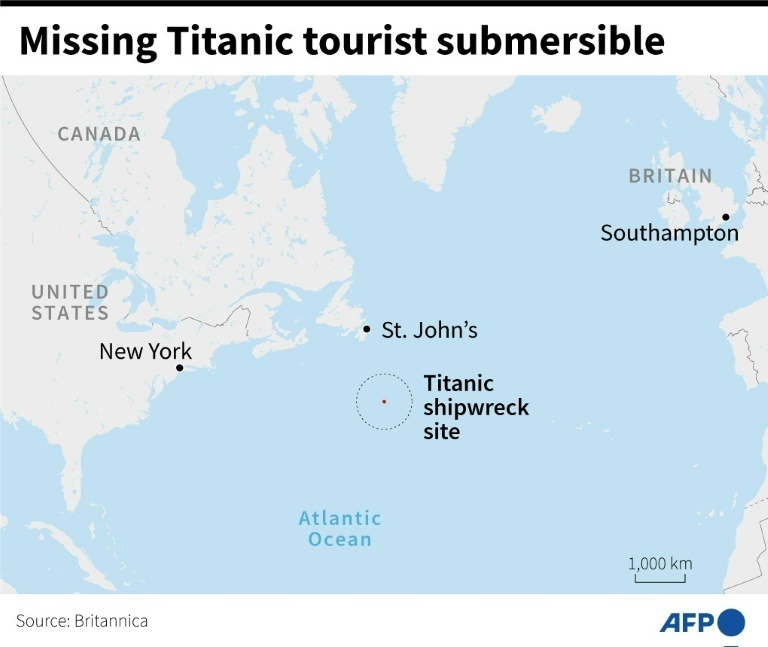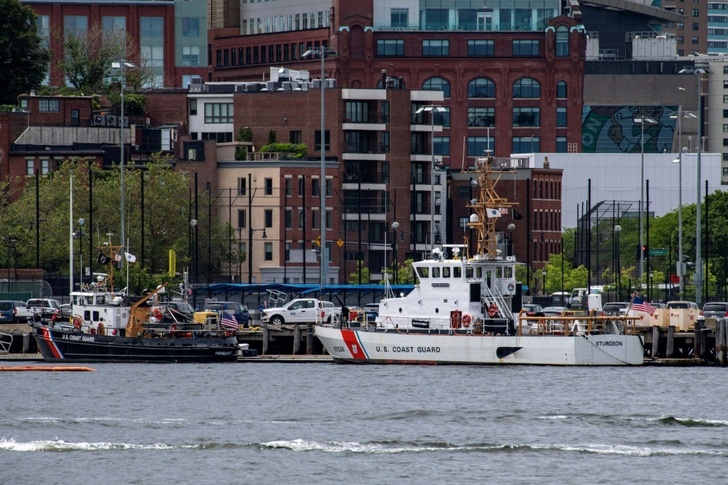Rescue teams raced against time on Tuesday to find a deep-diving tourist submersible that went missing near the wreck of the Titanic with five people on board.
All communication was lost with the 21-foot (6.5-meter) Titan craft during a descent Sunday to the Titanic, which sits at a depth of crushing pressure more than two miles below the surface of the North Atlantic.
The submersible was carrying three fee-paying passengers including British billionaire businessman Hamish Harding and prominent Pakistani tycoon Shahzada Dawood and his son Suleman.
The US and Canadian Coast Guard have deployed ships and planes in an intensive air and sea search for the vessel, which is equipped with just four days of emergency oxygen.
In an Instagram message posted just before the dive, Harding said a mission window had opened after days of bad weather. Among the crew named by Harding was Paul-Henry Nargeolet, a veteran diver and expert on the Titanic wreck.
Unconfirmed media reports said the fifth person on board was Stockton Rush, the CEO of OceanGate Expeditions which operates the tourist dives.
The Titan began its descent to the wreck on Sunday but lost contact with the surface less than two hours later, according to authorities.
"We are exploring and mobilizing all options to bring the crew back safely. Our entire focus is on the crewmembers in the submersible and their families," OceanGate said in a statement.
Mike Reiss, an American television writer on "The Simpsons" who visited the Titanic wreck on the same sub last year, told the BBC the experience of being so far down in the ocean was disorientating. The pressure at that depth as measured in atmospheres is 400 times what it is at sea level.
"The compass immediately stopped working and was just spinning around and so we had to flail around blindly at the bottom of the ocean, knowing the Titanic was somewhere there," Reiss said.
"But it's just so pitch dark that the biggest thing under the ocean was just 500 yards away and we spent 90 minutes looking for it."
He told the BBC that everyone was aware of the dangers. "You sign a waiver before you get on and it mentions death three different times on page one.
"This isn't a coach holiday or something. Things go wrong."
- 'Legendary explorers' -
According to its website, OceanGate Expeditions charges $250,000 for a seat on the Titan.
Harding, a 58-year-old aviator, space tourist and chairman of Action Aviation, is no stranger to daredevil antics -- and has three Guinness world records to his name.
A year ago, he became a space tourist through Amazon founder Jeff Bezos's Blue Origin company.
In his Instagram post, Harding said how proud he was to be part of the latest mission.
"Due to the worst winter in Newfoundland in 40 years, this mission is likely to be the first and only manned mission to the Titanic in 2023," he wrote.
"The team on the sub has a couple of legendary explorers, some of which have done over 30 dives to the RMS Titanic since the 1980s including PH Nargeolet," the post added.
Shahzada and Suleman Dawood hail from one of Pakistan's richest families that runs an investment and holding company headquartered in Karachi.
Shahzada is the vice chairman of the subsidiary company Engro, which has an array of investments in energy, agriculture, petrochemicals and telecommunications.
- 'Clock is ticking' -
The Titanic hit an iceberg and sank in 1912 during its maiden voyage from England to New York with 2,224 passengers and crew on board. More than 1,500 people died.

It was found in 1985 and remains a source of fascination and a lure for nautical experts and underwater tourists.
Without having studied the craft itself, Alistair Greig, professor of marine engineering at University College London, suggested two possible theories for the Titan's situation based on images of the vessel published by the press.
He said if it had an electrical or communications problem, it could have surfaced and remained floating, "waiting to be found" -- bearing in mind the vessel can reportedly be unlocked from the outside only.
"Another scenario is the pressure hull was compromised -- a leak," he said in a statement. "Then the prognosis is not good."
While the submersible may still be intact during its dive, "there are very few vessels" able to go to the depth to which the Titan might have travelled.
"The clock is ticking, and any submariner/submersible deep divers know how unforgiving the Abyssal domain is: going undersea is as, if not more, challenging than going into space from an engineering perspective," said University of Adelaide associate professor Eric Fusil in a statement.
bur/ec
© Agence France-Presse
Your content is great. However, if any of the content contained herein violates any rights of yours, including those of copyright, please contact us immediately by e-mail at media[@]kissrpr.com.
Source: Story.KISSPR.com

